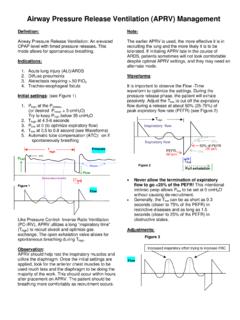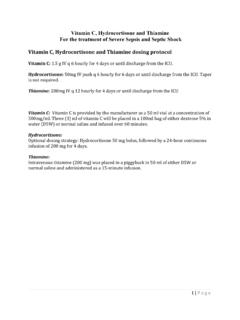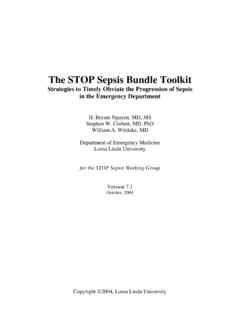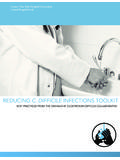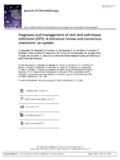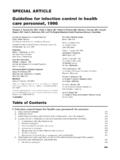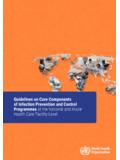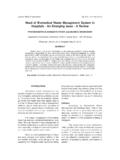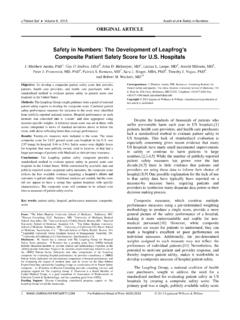Transcription of Allogeneic Blood Transfusion Increases the Risk of ...
1 Allogeneic Blood Transfusion Increases the Risk ofPostoperative Bacterial Infection: A Meta-analysisGary E. Hill, MD, William H. Frawley, PhD, Karl E. Griffith, MD, John E. Forestner, MD, andJoseph P. Minei, MDBackground:Immunosuppression isa consequence of Allogeneic (homologous) Blood Transfusion (ABT) in humans and isassociated with an increased risk in cancerrecurrence rates after potentially curativesurgery as well as an increase in the fre-quency of postoperative bacterial infec-tions. Although a meta-analysis has beenreported demonstrating the relationshipbetween ABT and colon cancer recur-rence, no meta-analysis has been reporteddemonstrating the relationship of ABT topostoperative bacterial :Twenty peer-reviewed arti-cles published from 1986 to 2000 were in-cluded in a meta-analysis.
2 Criteria for inclu-sion included a clearly defined controlgroup (nontransfused) compared with atreated (transfused) group and statisticalanalysis of accumulated data that includedstepwise multivariate logistic regressionanalysis. In addition, a subgroup of publica-tions that included only the traumaticallyinjured patient was included in a separatemeta-analysis. A fixed effects analysis wasconducted with odds ratios obtained by us-ing the conditional maximum likelihoodmethod and 95% confidence intervals onthe obtained odds ratios were determinedusing the :The total number of subjectsincluded in this meta-analysis was 13,152(5,215 in the transfused group and 7,937 inthe nontransfused group).
3 The commonodds ratio for all articles included in thismeta-analysis evaluating the association ofABT to the incidence of postoperative bac-terial infection was (range, ),with 17 of the 20 studies demonstrating avalue ofp< These results provideoverwhelming evidence that ABT is associ-ated with a significantly increased risk ofpostoperative bacterial infection in the sur-gical patient. The common odds ratio of thesubgroup of trauma patients was (range, ), with all studies showing avalue ofp< ( ). These re-sults demonstrate that ABT is associatedwith a greater risk of postoperative bacte-rial infection in the trauma patient whencompared with those patients receivingABT during or after elective :These results demon-strate that ABT is an associated and ap-parently significant and frequently over-looked risk factor for the development ofpostoperative bacterial infection in thesurgical patient.
4 Allogeneic Blood transfu-sion is a greater risk factor in the trau-matically injured patient when comparedwith the elective surgical patient for thedevelopment of postoperative Words:Meta-analysis, Bloodtransfusion, Immunosuppression, Postop-erative infection, ;54:908 bacterial infections remain a serious prob-lem in the surgical patient, causing increased morbidityand mortality, total hospital costs, and total length ofhospital stay. Although Allogeneic (homologous) Blood trans-fusion (ABT) may be essential in the management of thesurgical patient, several investigators have reported increasedinfection rates after ABT.
5 The increased risk of postoperativebacterial infection is dose related, that is, as the number oftransfused units Increases , the risk of infection ,2 Immunosuppression is a known consequence of ABTand Increases the cancer recurrence and mortality rates afterpotentially curative surgery in addition to increasing postop-erative bacterial infection meta-analysis on the ex-isting literature evaluating the relationship between ABT andcolorectal cancer recurrence rates after potentially curativesurgery has previously been primary strengthof a meta-analysis is the potential to increase statistical powerby combining the number of experimental subjects fromindividual studies into an inclusive overall analysis andthereby
6 Increasing statistical confidence. To date, no meta-analysis of the currently existing literature evaluating therelationship of ABT to the incidence of postoperative bacte-rial infections has been AND METHODSOur goal was to identify all relevant prospective con-trolled human clinical trials available for review and pub-lished by October 2001. A prospective controlled clinical trialwas defined as a trial in which the included subjects receivedone of two (or more) interventions and, in this case, wereseparated into a clearly defined treated ( Transfusion ) groupand an untreated control (nontransfused or placebo) group.
7 AMEDLINE literature search of peer-reviewed publicationswas performed by hand using the key words Blood transfu-sion, postoperative infection, immunosuppression, andSubmitted for publication January 14, for publication April 30, 2003 by Lippincott Williams & Wilkins, the Departments of Anesthesiology and Pain Management( , , ), Academic Computing Services ( ), and Sur-gery, Section of Burns, Trauma, and Critical Care ( ), Parkland Me-morial Hospital and the University of Texas Southwestern Medical Center atDallas, Dallas, for reprints: Gary E. Hill, MD, Department of Anesthesiologyand Pain Management, University of Texas Southwestern Medical Center atDallas, 5323 Harry Hines Blvd.
8 , Dallas, TX : Journal ofTRAUMA Injury, Infection, and Critical Care908 May 2003 trauma. In addition, only articles including stepwise mul-tivariate logistic regression analysis as a portion of theirstatistical evaluation of collected data were included. Stan-dard medical criteria were used to determine the presence ofpostoperative bacterial infection in each study. All studies inthis meta-analysis used standard laboratory-determined cross-matched human Allogeneic Blood for Transfusion AnalysisFor the analysis, the odds ratio was defined as the oddsof the Transfusion (treated) group divided by those of thenontransfused (placebo) group.
9 A fixed effects analysis wasconducted, with the point estimates of the odds ratios ob-tained by using the conditional maximum percent confidence intervals on theodds ratios were computed using the test6was used to determine homogeneity of theindividual odds ratios. Least squares regression was used toinvestigate possible linear relationships of odds ratio esti-mates to sample size, chronologic ordering, and observed riskin the groups of patients that did not undergo a funnel plot as described by Egger and Smith8was con-structed to determine whether selection, publication, citation,multiple publication, or inclusion bias was present in articleselection.
10 Implementation was carried out with the StatXactand S-Plus software packages. Values ofp wereconsidered articles published between 1986 and 2000 metthe criteria for 28 The total number of subjectsincluded in this meta-analysis was 13,152 (overall n 13,152, with 5,215 included in the Transfusion group and7,937 in the nontransfused group (Table 1). The odds ratiosranged from to , with a common odds ratio of of the 20 studies evaluated had accompanyingvalues ofp All point estimates of the odds ratios weregreater than unity and the lower boundary of most confidenceintervals were not less than 1 (Fig.))
